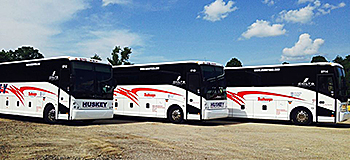
GPS tracking provides an efficient future
By Jonathan Durkee
Huskey Trailways built its name transporting precious cargo. No less than two U.S. presidents and their 90-person entourages have chartered its motorcoaches while traveling through Missouri. The U.S. military regularly relies on it to transport personnel. And students participating in the government’s Job Corps youth training program travel halfway across the country on the fleet.
“The importance of knowing where our fleet is and what it’s doing—that’s just of the ultimate importance to us,” Huskey Trailways owner Kent Huskey says.
GPS fleet management was new to Huskey, but motorcoach management software has definitively proven its worth since he integrated it into his 25 motorcoaches in November 2013. In addition to helping Huskey track the fleet’s whereabouts across the U.S., Fleetmatics’ solutions let Huskey monitor maintenance needs, idling times, driver speed, fuel consumption, departure and arrival times, and so much more.

Perfect match
Huskey spent about a year researching numerous providers before deciding on his current motorcoach management system. It didn’t take long for Huskey to confirm he made the right choice.
“The first weekend, Fleetmatics identified issues that I had an idea we had problems with, but now we could see it in black and white,” he says.
One of those launch weekend discoveries was exactly how much time his drivers spent idling between journeys. Huskey Trailways policy stipulates that drivers can idle their vehicles 30 minutes prior to departure and 30 minutes after. It’s an important cost-containing rule, considering the high price of diesel fuel.
Huskey tries to enforce it by occasionally making trips to the field during which he visits departure and arrival points. But with a territory that stretches the entire continental U.S., he can’t be everywhere all the time.
The motorcoach management solution revealed that 25 buses spent a total of 54 hours idling over just a three-day period—far exceeding their allotted idling time. Huskey was able to provide concrete evidence to his drivers that he knew about their habits and saw fuel economy improve immediately.
“This gives me the capability of knowing what they’re doing, where they’re at, and whether they’re behaving,” he says.
Driver approved
While Huskey’s drivers were initially skeptical about such close monitoring, they quickly realized that the software provider, Fleetmatics, was a big brother that would have their backs.
In January, Huskey Trailways transported dozens of teenagers from Michigan to Kentucky. The bus was scheduled to stop at Chicago’s Union Station at 3:20 a.m. and pick up additional kids. It arrived at 3:15 a.m.—five minutes early—and left at 3:29 a.m., giving the kids a 14-minute window around the pick-up time to get on the bus.
A program leader called Huskey about an hour later and says that the driver left early, abandoning 15 students on the station platform. Fleetmatics showed the actual arrival and departure times, proving that the driver had followed instructions.
“And the program leader said, ‘OK, not your problem. We’ll put them on a train,’” Huskey says. “Without Fleetmatics, we would have had to turn the bus around because it would have been their word against my driver’s.”
Returning to Chicago after one hour of driving would have cost Huskey two hours of fuel, two hours of time and two hours of salary—not to mention he would have had to schedule a second driver to finish the job because it would have put the first driver over his work limit for the day. Huskey estimates the company saved $1,000 from just that one report.
Word about how the system verified this driver’s account of the incident quickly spread throughout the team, ensuring buy-in from all the drivers. They realized that it protected them, Huskey says, as much as it monitored them.
“If I get complaints,” he says, “they know I go straight to this.”
A more efficient future
Anytime a driver speeds, Huskey gets an alert on his smartphone that he can forward directly to the driver. It’s a subtle way to let the driver know he needs to slow down before he gets a ticket.
Mechanics can swiftly figure out issues—or determine non-issues—from remote locations. A driver might report problems with his bus, for example, and the mechanic can activate a minute-by-minute route replay, see that the driver was traveling up a hill and determine that the incline, not a mechanical problem, bogged down the bus.
Efficient mechanical issue monitoring has also served Huskey Trailways well as the Department of Transportation (DOT) boosts the number of inspections it performs on motorcoaches. DOT performed three random inspections on Huskey’s fleet in 2013; in January 2014 alone, they did 16. The stakes are high, considering DOT has the authority to shut down bus companies found with violations.
“They’re starting to stop us more, and we need to know what our buses are doing and how they’re doing it,” he says.
On the occasions buses do break down, Huskey can quickly locate the disabled vehicle as well as the closest functioning bus, ensuring only minor disruption to passengers’ travels. When the wind chill hit 30 below zero in Wisconsin this winter, for example, one bus refused to start. Instead of going to dispatch, Huskey clicked on the option to find the nearest bus. A vehicle just 150 miles away was able to detour to Wisconsin and pick up the passengers.
It all adds up to a wise investment.
Jonathan Durkee serves as vice president, products & sales, product management, for Fleetmatics, Waltham, MA. Fleetmatics is a leading global provider of mobile workforce solutions for service-based businesses of all sizes delivered as software-as-a-service (SaaS). Visit www.fleetmatics.com
